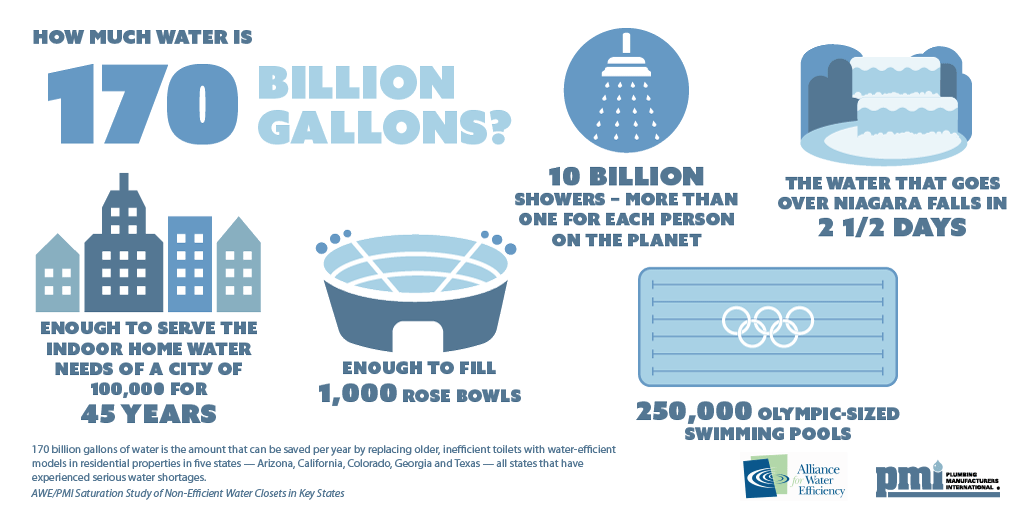PMI's Water Efficiency Studies
Plumbing Manufacturers International (PMI) has teamed up with allies and researchers to explore the use of and potential for water-efficient plumbing products to save water.
Legacy product replacement saves a high volume of water quickly
A 2022 Plumbing Manufacturers International (PMI)-commissioned study of the market penetration of mandated water-efficient fixtures in California finds a continuing and strong need to replace older plumbing fixtures, known as legacy products, with new ones. Installing water-efficient plumbing products quickly takes on increased urgency as we seek solutions to water shortages caused by the continuing drought.
Conducted by GMP Research, the California Market Penetration of Water-Efficient Plumbing Products Study finds the residential market penetration of water-efficient 1.28 gallons per flush (gpf)-or-less toilets to range from 22.0% to 25.9% in the five state regions surveyed. The market penetration in disadvantaged communities was even lower, ranging from 19.6% to 22.2% in the five regions.
Read more about Saving Water Quickly Through Legacy Product Replacement.
Most American Homes Have Plumbing Products That Meet Federal Water-Efficiency Standards, But Not WaterSense Standards
A study of 137.4 million American homes found that most American homes have water-efficient bathroom faucets, showerheads or toilets installed in them, according to a report commissioned by PMI and published by GMP Research, Inc.
The study also included 11.8 million non-residential commercial facilities, which also virtually all have water-efficient plumbing products installed.
“Since federal water-efficient standards were implemented in 1994, America has gradually replaced older bathroom faucets, showerheads and toilets with water-efficient ones,” said PMI CEO/Executive Director Kerry Stackpole. “Today, 26 years later, America is saving billions of gallons of water each year with water-saving plumbing products.”
Titled the “U.S. WaterSense Market Penetration Report,” the June 2019 report estimates that 81.4 percent of installed toilets in America meet federal water-efficiency standards and that virtually all installed showerheads and bathroom faucets meet the standards. The federal water-efficiency standards are 1.6 gallons per flush (gpf) for toilets, 2.2 gallons per minute (gpm) for bathroom faucets, and 2.5 gpm for showerheads.
The report also includes national and state data about the use of WaterSense products, which use at least 20% less water than products meeting federal standards. For example, WaterSense-certified tank-type toilets have 16.8 percent market share nationwide. WaterSense-certified bathroom sink faucets have 40.1 percent market share, and WaterSense-certified showerheads have 45.4 percent market share. WaterSense products are at least 20 percent more water efficient than products meeting the federal standard.
Download the 2019 WaterSense Market Penetration report.
Water-efficient toilets can save hundreds of billions of gallons of water each year
Water-efficient toilets could potentially save up to 170 billion potable gallons of water per year across five states facing water scarcity, according to research released in 2017 by the Alliance for Water Efficiency (AWE) and Plumbing Manufacturers International (PMI). This five-state savings can be extrapolated to an estimate of up to 360 billion potable gallons of water per year saved nationally.
The “Saturation Study of Non-Efficient Water Closets in Key States” focused on Arizona, California, Colorado, Georgia and Texas – all states that have experienced serious water shortages. The savings projected by the study (170 billion gallons of potable water yearly or 465 million gallons saved per day) could be achieved if non-efficient toilets in residential properties are replaced with water-efficient ones.
Using the AWE/PMI study estimate of 170 billion gallons of water, these examples show how much water can be saved within residential properties located in the five states included in the study:
- Enough water saved to take 10 billion showers – more than one for each person on the planet
- Enough water saved to serve the indoor home water needs of a city of 100,000 for 45 years
- Enough water saved to fill 250,000 Olympic-sized swimming pools
- Enough water saved to fill 1,000 Rose Bowls
- Enough water saved to equal the water that goes over Niagara Falls in 2 1/2 days

